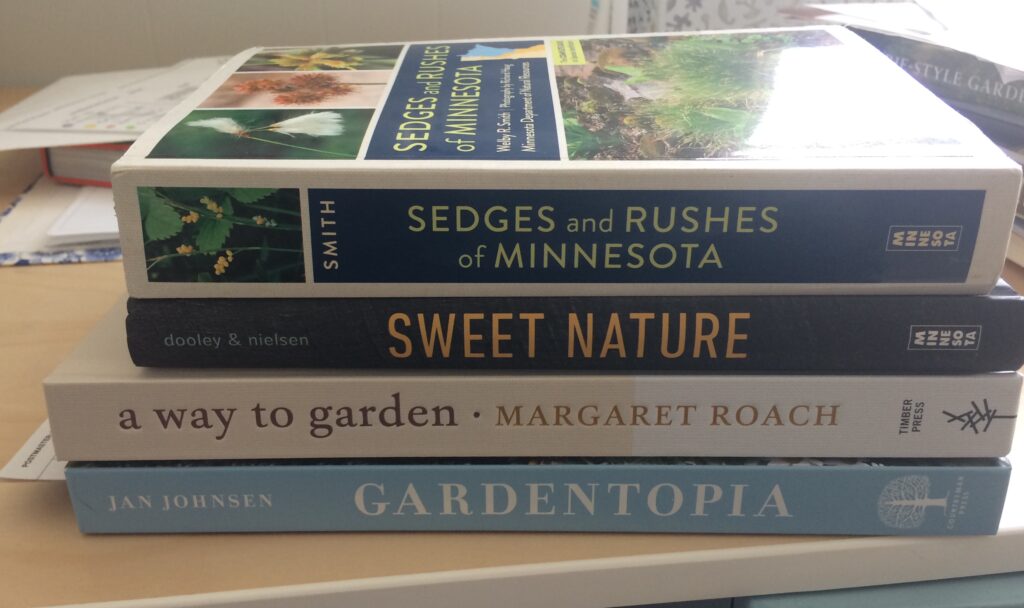A Bouquet of Book Reviews for Spring
 It’s spring, and along with the daffodils and spring ephemerals, it’s a time when new books of interest to gardeners emerge. Here are four mini book reviews of newer books we like.
It’s spring, and along with the daffodils and spring ephemerals, it’s a time when new books of interest to gardeners emerge. Here are four mini book reviews of newer books we like.
A Way to Garden (Timber Press, 2019) by Margaret Roach is a revision to the book Roach published more than 20 years ago. It’s a beautiful hardcover book, filled with photos of Roach’s large garden in New York state. But the writing is what I really like about this book. Roach is a stylist, both in the garden and on the page.
Here’s Roach on lilacs: “Being Northern-raised, it is hard not to have a soft spot for lilacs, with those voluptuous flowers and that scent. At the start, I made room for many, but as they have sometimes outgrown their spaces I find that I have likewise outgrown lilacs a bit.”
In A Way to Garden, Roach divides the year in the garden into six two-month stretches from Conception to Death and Afterlife. While our seasons are more compressed farther North, this way of thinking about the garden is helpful for planning. Along the way, she covers many garden essentials: choosing hybrids or heirlooms, dealing with nuisance wildlife, why seedlings stretch and get spindly, mulch, roses, potatoes, garlic—really the whole garden and the whole year. Her thoughts on creating “mosaics” under trees are instructive, though I’m sure my efforts will never match the stunning plantings under her 100-year-old apple trees.
A Way to Garden has a release date of April 30, so it may not be in stores yet, but should be in time for Mother’s Day. This is a garden book to read not just look at the pictures.

Gardentopia: Design Basics for Creating Beautiful Outdoor Spaces (Countryman Press, 2019) by Jan Johnsen is a design how-to book with plenty of inspiration thrown in. I wrote about her thoughts on the bones of a garden in a mini book review on my personal blog, but Johnsen has 134 more ideas about how to imagine a space, planning, planting, and carrying out your design ideas. Her tips are practical (“How big a patio do you need?” or “Angelonia stonecrop—a garden workhorse”) but they also ask the big questions that garden design inspires (“Why we garden” or “Respect the genius of the place”). This is a book you can dip in and out of as design issues present themselves.
Sweet Nature: A Cook’s Guide to Using Honey and Maple Syrup (University of Minnesota Press, 2019) by Beth Dooley and Mette Nielsen is a cookbook rather than a gardening book, but many gardeners also tap maple trees or raise bees and the book has a surprising number of recipes highlighting garden produce. Dooley and Nielsen have collaborated on two other regional cookbooks and independently have photographed and written on a variety of food topics. Sweet Nature explores all the ways that honey and maple syrup can be used in cooking, from breakfast granola to salad dressings to savory main dishes with just a touch of sweetness. Their recipe for Garlicky Collards or Kale, featuring honey, vinegar and six cloves of garlic, is just the dish for using up an abundance of greens. I’m bookmarking the recipe for Old-fashioned Corn Pudding for late August and have already whipped up a batch of the Lime, Pomegranate and Honey Dressing, which was spicy, sweet and delicious.
 Our last book is Sedges and Rushes of Minnesota (University of Minnesota Press, 2018) by Welby R. Selby with photographs by Richard Haug and assistance from the Minnesota Department of Natural Resources, where Selby is the state botanist. The subtitle of the book is “The Complete Guide to Species Identification” and that is no understatement. The author reviews hundreds of species of sedges (in Minnesota, mostly Carex species) and rushes and complete the picture with photographs of plants, flowers and seeds. Both plants look like grasses but are not. The book can get technical in places. But if you live near wild areas and want to understand the plants around you or just want to use these valuable plants in your landscape, the book has great value.
Our last book is Sedges and Rushes of Minnesota (University of Minnesota Press, 2018) by Welby R. Selby with photographs by Richard Haug and assistance from the Minnesota Department of Natural Resources, where Selby is the state botanist. The subtitle of the book is “The Complete Guide to Species Identification” and that is no understatement. The author reviews hundreds of species of sedges (in Minnesota, mostly Carex species) and rushes and complete the picture with photographs of plants, flowers and seeds. Both plants look like grasses but are not. The book can get technical in places. But if you live near wild areas and want to understand the plants around you or just want to use these valuable plants in your landscape, the book has great value.

One Comment
-
Pingback: What's a Gardener To Do? - Minnesota State Horticultural Society
Back to Blog